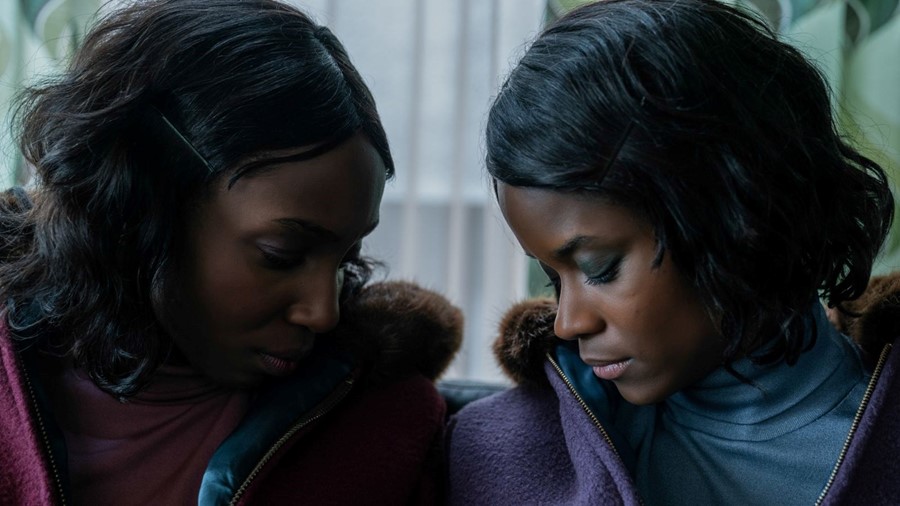The Silent Twins tells the story of June and Jennifer Gibbons, twin sisters who spoke only to each other. Here, actors Letitia Wright and Tamara Lawrance talk about representing the pair with “integrity, and beauty and love”
When Tamara Lawrance told a friend she’d been cast as Jennifer Gibbons, one of the so-called ‘silent twins’ who spent 11 years in Broadmoor with her sister during the 1980s, her response was telling. “Ohhh, you’re playing those murderers!” her friend exclaimed, displaying foggy recall, perhaps, of the press generated by the story, which tended to run from the rubbernecking to the outright ghoulish.
“That’s when I understood they’d been completely misrepresented,” says Lawrance, sitting with her co-star, Letitia Wright, the day after a successful night at the British Independent Film Awards, where they won best joint performance for their roles in The Silent Twins. “I knew they didn’t speak and there was a lot of mystery around them. But as we delved into the research for this project it kind of blew my mind that they were really very normal and what happened was scandalous, really. Their story is rooted in injustice.”
Directed by Agnieszka Smoczyńska, The Silent Twins tells the story of June and Jennifer Gibbons, born in Yemen to Bajan parents who came to the UK in the early 1960s. Eventually settling in Haverfordwest, a remote Welsh community where the girls were bullied as the only Black kids at school, June and Jennifer began a worrying retreat into their own private worlds, refusing to speak at first with their teachers and schoolmates, and finally with members of their own family. But behind closed doors, they did speak with each other, in an idiosyncratic form of sped-up Bajan Creole which even their parents struggled to untangle. It was as if their silence was a form of protest, designed to draw out the racism, latent and otherwise, inherent in British society. At the same time, it was a spell they struggled to break free of.
“June and Jennifer’s relationship was really complex,” says Wright, who plays June in the film. “Their silence was to protect themselves in a way, because they were clearly marginalised at school and in their neighbourhood for being Black, and when you go through something like that as a kid you really just want to shut down. And their way of solving it was to try and disappear as much as possible – you know, if we keep everything small and synchronised we won’t be bullied. But what started as a pact of silence grew into something more, something that was a little bit dangerous.”

By the time they hit their teens, the girls had begun keeping diaries – whose entries informed much of The Silent Twins’ story – and fictional works reflected through a series of fantasy sequences in the film. Vivid and insightful, their stories revealed the parts of themselves the girls kept well-hid, contradicting the verdict of a society not curious enough to care. “It was a real blessing to have that lens into everything they were experiencing,” says Lawrance. “To see how much the themes of sisterhood and identity [were there], and also a sort of foreboding, a foreshadowing of things in their own life.” In one diary entry, brought to life in the film by Barbara Rupik’s unnerving, Jan Švankmajer-esque animation, Jennifer sketches the story of two parrots in a cage, stripped of their feathers and dreaming of a return home. It’s an expression of deep cultural loss and loneliness that’s also a tragic premonition of what was to come.
As the girls’ creativity blossomed, so did their appetite for acts of petty vandalism, culminating in an arson attack on a local tractor store. In 1982, June and Jennifer were sent to Broadmoor, the notorious, high-security psychiatric hospital where Yorkshire ripper Peter Sutcliffe and Ronnie Kray were held, on an indefinite sentence. They were just 19. What transpired over the next 11 years was tragic, a catastrophic failure of the British justice system which Tim Thomas, the educational psychologist played by Michael Smiley in the film, told The New Yorker had less to do with the danger the girls presented to the public than the colour of their skin: “They were putting a label on these children – that is what I thought they were – as psychopaths. How the hell can you decide that somebody has a mental health problem as serious as that if you don’t communicate with them? Expediency. Had they been white and middle class, the outcome would have been different.”

In the years since the girls’ release from Broadmoor, the Gibbons family have mostly shied away from the public eye as they attempted to rebuild their lives. June was consulted by the girls’ biographer, Marjorie Wallace, about the film, and the responsibility of playing such a vulnerable, and historically wronged, character seems to weigh heavily on Wright, in particular. “They were traumatised by the media and [don’t want] that to be repeated,” she says. “June lives a private life so we didn’t want to bombard her with our questions; it’s quite triggering to go back into all that.” Has she seen the film? “Ah man, it’s really tough to say because she’s private. When Marjorie saw it she gave word to June that it was done with care and there was nothing to be afraid of. The way we represented the twins was with integrity, and beauty and love.” And that’s just what Wright and Lawrence deliver with their performances. The Silent Twins honours June and Jennifer’s tragically interwoven story as one about love, its mysteries, and why we tell stories in the first place.
The Silent Twins is out in UK cinemas today.
